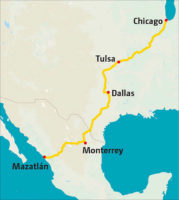A union representing government engineers in Ontario is taking aim at a pair of newly released reports on the deck problem that temporarily closed the newly opened Nipigon River Bridge last winter, severing a major highway link between eastern and western Canada.
The reports by the Ontario Ministry of Transportation and independent consultant Associated Engineering should have delved deeper and looked at potential management and oversight issues with the construction of Ontario’s first cable-stayed bridge, the Professional Engineers Government of Ontario contends.
A 252-meter-long structure with spans of 113 and 139 m, the Nipigon River Bridge is about 60 miles from Thunder Bay. The bridge had been open only about six weeks. On Jan. 10, forty A490 bolts—connecting the tie-down bearing to the main girder’s bottom flange on the northwest bearing of the bridge—failed progressively. Provincial officials closed the bridge for a day when the unbalanced weight of the spans, acting through backstayed cables, pulled the northwest end of the bridge upward about 600 millimeters above the road level. For weeks, traffic was limited to a single lane, causing major disruptions in truck and commuter traffic and millions of dollars in lost business.
A transportation ministry review and a separate report by Associated Engineering both point the finger at various technical factors, including the “improper installation of the bolts,” that caused the deck to rise.
Specifically, the ministry report found that the failure of the bolts also was caused by a lack of “pretensioning of the bolts and lack of bevelled washers,” which led “to high fatigue stresses and a high-stress, low-cycle fatigue failure.”
The report also cited other major factors concerning the flexible shoe plate’s design, which led “to higher forces in the exterior line of bolts.” The report also noted the “bearing’s inability to accommodate rotation.” The bolts themselves were not an issue, the report stated.
But the ministry’s report also makes clear that management and review of the project were not on the table, leaving a key area unexamined, argues Ping Wu, president of the Professional Engineers Government of Ontario (PEGO). “It is clear that the mandate was not comprehensive to include examination of the processes or safeguards that failed to prevent the unfortunate sequence of events,” PEGO said in a statement.
There were a number of points in the project, including the review of contract specifications for the bearings, “where proper oversight could have forestalled the future failure,” said Wu.
A spokeswoman for the ministry, Andrea Ernesaks, said management and oversight issues may be explored later as Ontario transportation officials “sort out responsibility for the costs.”
Repairs to the bridge will cost an estimated $6.8 million to $9 million, transportation ministry officials have said.
MMM Group Ltd., a part of WSP Global Inc., designed the bridge, and a joint venture, Bot Ferrovial, built the span. The venture combines Bot Construction with Ferovial Agroman Canada, part of Madrid-based global infrastructure giant Ferovial.
Professional Engineers Ontario, which licenses engineers in the province, is now determining whether to launch its own investigation, said Gerard McDonald, the organization’s registrar. Mark Green, a professor and associate head of civil engineering at Queen’s University, Kingston, said the report’s conclusions made sense to him and seemed rigorous, but a review of processes is also a good idea.






Post a comment to this article
Report Abusive Comment